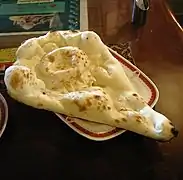Panipuri
Panipuri (![]() pānīpūrī ) or fuchka (
pānīpūrī ) or fuchka (![]() fhuchka ) or gupchup or golgappa is a type of snack that originated in the Indian subcontinent, and is one of the most common street foods in India, Nepal and Bangladesh.[1][2][3][4][5]
fhuchka ) or gupchup or golgappa is a type of snack that originated in the Indian subcontinent, and is one of the most common street foods in India, Nepal and Bangladesh.[1][2][3][4][5]
 Panipuri | |
| Alternative names | Paani patashi (Haryana and Madhya Pradesh) Pani ke batashe (Uttar Pradesh) Golgappa, gol gappay or gol gappa (Delhi, Punjab) Fuchka ফুচকা (Bangladesh, West Bengal, Bihar, Nepal) Phuska/Puska (Assam) Fuska ফুসকা/ফুছকা (Sylhet and Chittagong) Gup-chup (Odisha, Andhra Pradesh, Telangana, Southern Jharkhand, Chhattisgarh) Panipuri (Gujarat, Maharashtra ) |
|---|---|
| Type | Snack |
| Place of origin | India |
| Region or state | Indian subcontinent |
| Main ingredients | Flour, spiced water, onions, potatoes, chickpeas |
| Variations | Sev puri, Puri |
Ingredients
Panipuri consists of a round or ball-shaped, hollow puri (a deep-fried crisp flatbread), filled with a mixture of flavored water (known as imli pani), tamarind chutney, chili powder, chaat masala, potato mash, onion or chickpeas.[6][7]
Fuchka (or fuska or puska) differs from Panipuri in content and taste. It uses a mixture of boiled yellow peas and spiced mashed potatoes as the filling with sliced onion mixture as the toppings. It is tangy rather than sweetish while the water is sour and spicy.[8]
Names
Panipuri's name varies depending on the region. In Haryana it is known as paani patashi; in Madhya Pradesh fulki; in Uttar Pradesh pani ke batashe/padake ; in Assam phuska/puska; Pakodi in parts of Gujarat, Gup-chup in Odisha, Telangana, South Jharkhand, Chhattisgarh and Andhra Pradesh[9] Phuchka in Bengal, Bihar and Nepal. It is popular by the name of Gol Gappa (/gəʊlˈgʌpə/) in some parts of Northern India (particularly Delhi and Punjab).[8]
On 10 March 2005, "pani puri" was added to the Oxford English Dictionary.[10]
History
Chaat is considered the predecessor of pani puri. According to the culinary anthropologist Kurush Dalal, chaat originated in Northern India (now Uttar Pradesh) during the Mahabharat era. According to this claim, Draupadi in the Mahabharat impressed her mother-in-law, Kunti, by being able to turn dough for just one puri and some potatoes into pani puri to feed her five husbands. However, this story does not have any historical evidence for it and is considered a myth by historians. Food historian Pushpesh Pant opines that pani puri originated in North India (around modern-day Uttar Pradesh and Bihar), about 100 to 125 years ago. He also noted that it was possibly originated from Raj-Kachori. Someone made a smaller puri and made a pani puri from it.[11] Pani puri spread to the rest of India mainly due to migration of people from one part of the country to another in the 20th century.[4]
Gallery
References
- khadizahaque (30 November 2014). "Chotpoti and Fuchka , The most popular Street Food in Bangladesh". Khadiza's Kitchen. Retrieved 1 October 2020.
- "Fuchka/Chotpoti: a true Bengali delicacy". Daily Sun. Retrieved 1 October 2020.
- Tarla Dalal, Chaat Cookbook., Gardners Books, 2000, 116 p. ISBN 978-81-86469-62-0
- Ramadurai, Charukesi (3 June 2020). "Pani Puri: India's favourite street food... at home?". BBC Travel. Retrieved 25 August 2020.
- "MANGEZ AU NÉPAL I; L'ALIMENTATION DE RUE". JAPANFM (in French). 19 December 2020. Retrieved 26 December 2020.
- Ramprasad, Gayathri (2014). Shadows in the Sun: Healing from Depression and Finding the Light Within. Hazelden. p. 260. ISBN 978-1-61649-531-2.
- "Easy Pani Puri (With Step by Step Photos)". Dassana's Veg Recipes. 3 August 2010. Retrieved 30 September 2020.
- Ladage, Rutu (9 May 2017). "11 Different Names For Your Favourite Pani Puri". The Times of India. Retrieved 12 June 2017.
- https://recipes.timesofindia.com/articles/features/there-are-10-different-names-for-pani-puri-how-many-do-you-know/photostory/63185223.cms
- "March 2005 Update". Oxford English Dictionary.
- "How Golgappa Originated | The tangy story of Golgappa-India's favorite street food!". The Times of India. 19 May 2020. Retrieved 30 September 2020.
| Wikimedia Commons has media related to Panipuri. |








